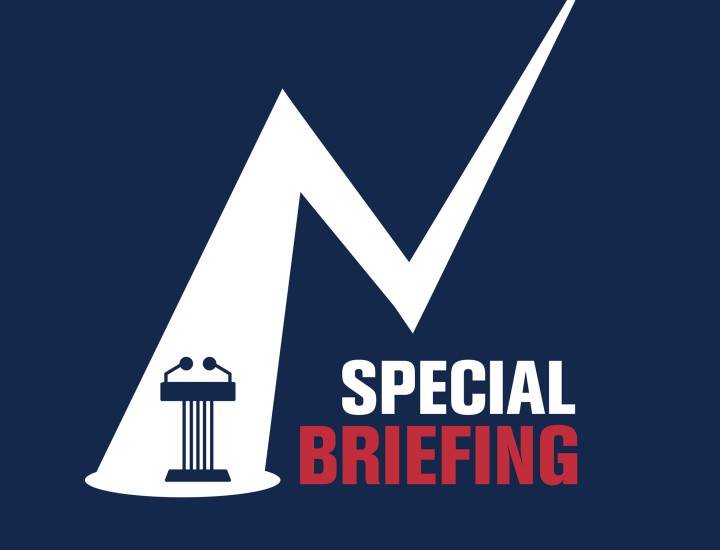Special Briefing: The Debt Ceiling Deal and its Impact on the US Economy, States, and Municipalities

11:00AM
The Volcker Alliance and Penn Institute for Urban Research hosted an online Special Briefing on fallout for the US economy, states, and municipalities from the recent deal to raise the federal debt ceiling.
Our panel of experts included Matt Fabian, partner, Municipal Market Analytics; Marcia Howard, executive director, Federal Funds Information for States; Annie Linskey, white house reporter, the Wall Street Journal; Vikram Rai, managing director and head of the municipal strategy group, Citigroup; and Torsten Slok, chief economist, Apollo Global Management.
Moderated by William Glasgall, Volcker Alliance senior director, public finance and Penn IUR fellow, and Susan Wachter, co-director of Penn IUR, this briefing was the forty-third in a series of sixty-minute online conversations featuring experts from the national research networks of the Volcker Alliance and Penn IUR, along with other leading academics, economists, and federal, state, and local leaders.
Special Briefings are made possible by funding from The Century Foundation, the Volcker Alliance, and members of the Penn IUR Advisory Board.
Recordings of the entire Special Briefings series are available on the Volcker Alliance website: SPECIAL BRIEFING SERIES ARCHIVE.
Be sure to subscribe to the Special Briefing podcast, available on Apple Podcasts, Spotify, Google Podcasts, Stitcher, TuneIn, iHeart Radio and more.
Special Briefing Episode Summary:
Municipal Market Faces More Hurdles After Debt Ceiling Deal
By Stephen Kleege, Volcker Alliance Special Project Consultant
- Biden's deal with McCarthy spared state, local governments from onerous cuts
- "Perilous, complicated, politically fraught" appropriations process looms
- Inflation, elevated interest rates seen persisting into 2024
- Investor base shrinks, as banks, insurers reduce muni footprints
- "The next fight ... will be about health care"
Though this month’s debt limit deal spared the municipal market from onerous cuts in federal fiscal support, panelists at a June 15 Special Briefing said state and local governments still face a risk of reduced federal spending while they also contend with inflation, high interest rates, reduced demand for their bonds, and a looming crisis in the health care sector.
The spending caps and clawbacks of COVID relief spending in the Fiscal Responsibility Act proved less disruptive to state revenue than some officials had feared, said Marcia Howard, executive director Federal Funds Information for States, at the webinar hosted by the Volcker Alliance and Penn Institute for Urban Research. But a “perilous, complicated, politically fraught” process lies ahead as some Republican lawmakers now say they want to set appropriations at fiscal 2022 levels, a substantial cut from the 2023 levels agreed to during debt negotiations.
Moderated by William Glasgall, Volcker Alliance senior director, public finance and Penn IUR fellow, and Susan Wachter, co-director of Penn IUR, the briefing was the forty-third in a series of sixty-minute online conversations featuring experts from the national research networks of the Volcker Alliance and Penn IUR, along with other leading academics, economists, and federal, state, and local leaders. In addition to Howard, the panel included: Matt Fabian, partner, Municipal Market Analytics; Annie Linskey, White House reporter, the Wall Street Journal; Vikram Rai, managing director and head of the municipal strategy group, Citigroup; and Torsten Slok, chief economist, Apollo Global Management.
“The debt ceiling deal was much smoother than many of us expected,” Linskey said, referring to the negotiations between House Speaker Kevin McCarthy and President Joe Biden that averted a default on United States debt. “Muscles were exercised that we did not really know existed.” The budget debate in the fall “is going to create another friction point,” she said, “with a little more room in the appropriations process for negotiations from the administration side.”
While state and local governments are currently flush with revenue from trillions of dollars in COVID-19 relief money, they face stiff economic headwinds. Slok said inflation remains elevated, at about 5 percent compared with the Federal Reserve target of 2 percent, and interest rates are likely to remain high well into 2024, raising borrowing costs for municipalities, consumers, and businesses. The consensus among economists calls for recession by next year that would reduce earnings and state tax revenue, he said. In addition, Slok said the lifting of the debt limit may lead to a glut of Treasury securities issuance, with negative implications for demand for municipal bonds.
Rai said banks and insurers are reducing their investment in municipal bonds. That means issuers “have to become more reliant on retail investors,” Rai said, “and they are more fickle.”
The return on municipal bonds has lagged behind that of other investments this year, he added. “For munis to become more attractive, they have to cheapen more, which does not bode well for state and local governments.”
Fabian said the crisis showed that it will be increasingly difficult for the federal government to downstream money to the states. “And when they downstream less money to states,” he said, “that means either the states pick up responsibility, or the states downstream those costs to locals or individuals’’ through taxes and fees.
Because the deal extended rather than eliminated the debt ceiling, “this drama is going play out again in 2025,” Rai said. “The next fight, unfortunately, is going to be about health care,” which accounts for about 25 percent of all federal spending. “We know the state of the health care system is eroding.”
“This year over $9 billion of hospital debt has disclosed some kind of technical default,” Fabian said. Not-for-profit hospitals are “absolutely a sector that investors are watching very closely.’’
 Matt Fabian is a Partner at Municipal Market Analytics (MMA) where he leads market and credit research. Mr. Fabian is the lead contributor MMA’s weekly Municipal Outlook and biweekly Municipal Default Trends. His expansive knowledge of the idiosyncratic characteristics of the municipal market has made him one of the primary voices of the industry. Prior to MMA in 2015, Mr. Fabian served in a similar capacity at Municipal Market Advisors since 2006.
Matt Fabian is a Partner at Municipal Market Analytics (MMA) where he leads market and credit research. Mr. Fabian is the lead contributor MMA’s weekly Municipal Outlook and biweekly Municipal Default Trends. His expansive knowledge of the idiosyncratic characteristics of the municipal market has made him one of the primary voices of the industry. Prior to MMA in 2015, Mr. Fabian served in a similar capacity at Municipal Market Advisors since 2006.
Prior to his current position, Mr. Fabian was the lead municipal research analyst for UBS and UBS Wealth Management Research. Earlier in his career he was an underwriting analyst at FSA, and a municipal rating analyst with Moody’s Investors Service.
Mr. Fabian has served as Chairman of the Municipal Analysts Group of New York (MAGNY) and was on the Board of Governors of the National Federation of Municipal Analysts (NFMA). He is routinely a featured speaker at numerous industry conferences on a wide range of topics, including investment strategy, demographic trends, bond insurance, tax reform, derivatives, defaults, state governments, and municipal credit. Mr. Fabian’s efforts in municipal default analysis led to the creation of MMA’s Credit Impairment Database, the most complete resource of troubled issuers in the industry.
Mr. Fabian has an undergraduate degree from Penn State University, and Master of Public Administration from the Maxwell School of Citizenship and Public Affairs at Syracuse University.

Marcia Howard has served as the executive director of Federal Funds Information for States (FFIS) since 1998. FFIS is a subscription service created by and affiliated with the National Conference of State Legislatures and the National Governors Association that provides subscribing states with data and analysis for more than 200 federal grant programs.
Howard also has worked for the National Association of State Budget Officers (NASBO), the federal government (ACIR), local government (Cincinnati), a public sector labor union (AFSCME), and internationally (with USAID in Grenada).
Howard writes State Policy Reports, a semi-monthly newsletter that reports on emerging issues of interest to states.
She holds a bachelor’s degree in foreign affairs from the University of Cincinnati and a master’s degree in applied economics from the University of Michigan.

Annie Linskey is a Wall Street Journal White House reporter. Previously, she was a national reporter covering the White House for the Washington Post and covered Democrats in the 2020 presidential campaign as a national political reporter for the newspaper. Linskey was also the lead reporter on Democrats for the Boston Globe Washington bureau during the 2016 campaign. She reported on the Obama White House for Bloomberg News and BusinessWeek. Linskey's first nine years in journalism were spent at the Baltimore Sun, where she covered crime, City Hall and the Maryland State House.
 Vikram Rai is the Head of Citi’s Municipal Strategy group. He has regularly been ranked in the top 3 in the Institutional Investor and the Greenwich client surveys. Formerly, he was in Citi US Rates trading and prior to joining Citi in 2007, Vikram worked for the hedge fund, Old Lane LLP in the private equity division. Vikram has an MBA in Finance and Economics from the University of Chicago and is a CFA charter holder.
Vikram Rai is the Head of Citi’s Municipal Strategy group. He has regularly been ranked in the top 3 in the Institutional Investor and the Greenwich client surveys. Formerly, he was in Citi US Rates trading and prior to joining Citi in 2007, Vikram worked for the hedge fund, Old Lane LLP in the private equity division. Vikram has an MBA in Finance and Economics from the University of Chicago and is a CFA charter holder.
 Torsten Slok is chief economist at Apollo Global Management’s executive office in New York. Prior to joining the firm in August 2020, he worked for 15 years on the sell-side, where his team was top-ranked by Institutional Investor in fixed income and equities for ten years, including No. 1 in 2019. Previously he worked at the OECD in Paris, in the Money and Finance Division and the Structural Policy Analysis Division. Before joining the OECD he worked for four years at the IMF in the division responsible for writing the World Economic Outlook and the division responsible for China, Hong Kong, and Mongolia.
Torsten Slok is chief economist at Apollo Global Management’s executive office in New York. Prior to joining the firm in August 2020, he worked for 15 years on the sell-side, where his team was top-ranked by Institutional Investor in fixed income and equities for ten years, including No. 1 in 2019. Previously he worked at the OECD in Paris, in the Money and Finance Division and the Structural Policy Analysis Division. Before joining the OECD he worked for four years at the IMF in the division responsible for writing the World Economic Outlook and the division responsible for China, Hong Kong, and Mongolia.
Torsten studied at University of Copenhagen and Princeton University. He frequently appears in the media (CNBC, Bloomberg, WSJ, NYT, FT), and has published numerous journal articles and reviews on economics and policy analysis, including in the Journal of International Economics, Journal of International Money and Finance, and The Econometric Journal.



